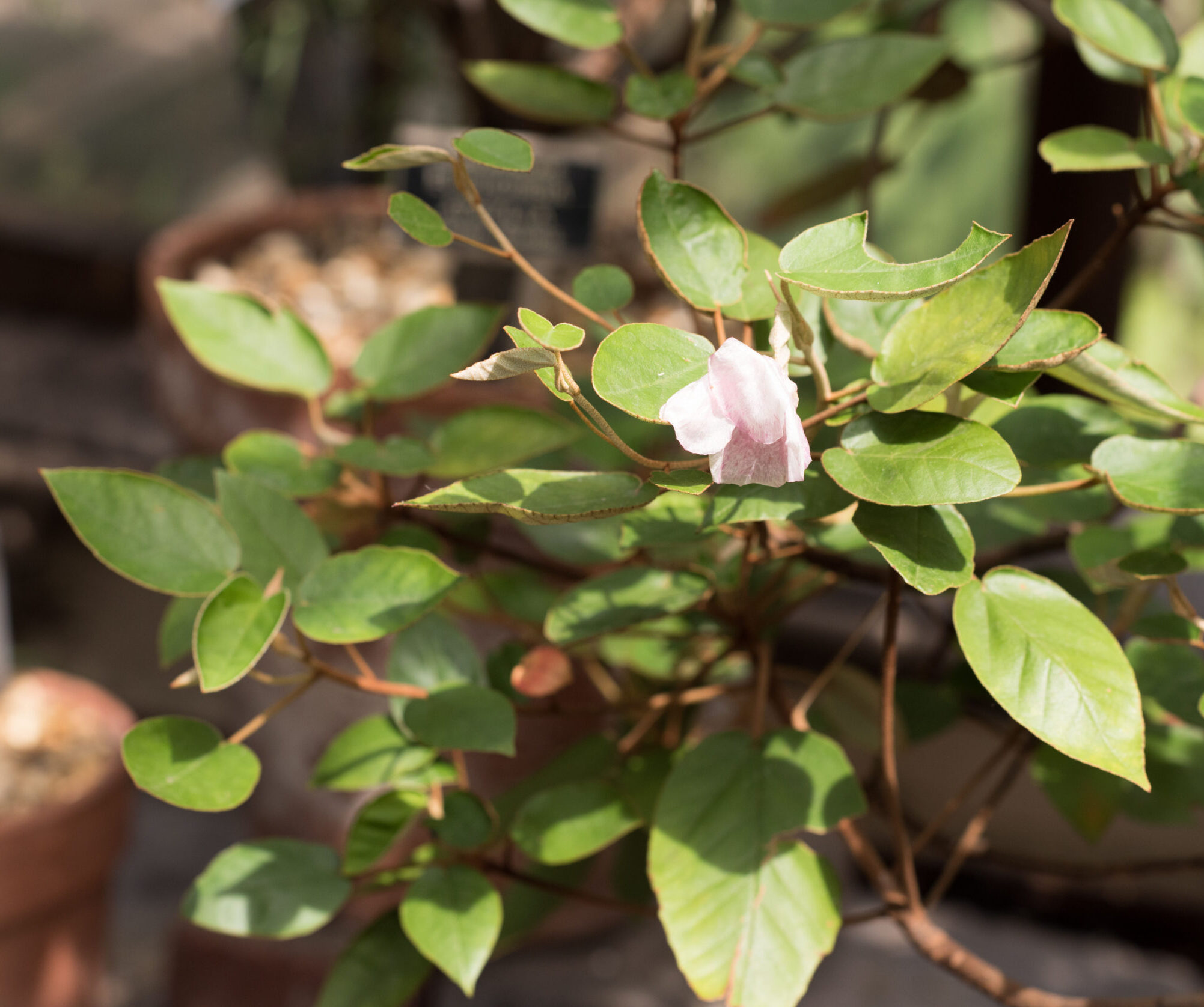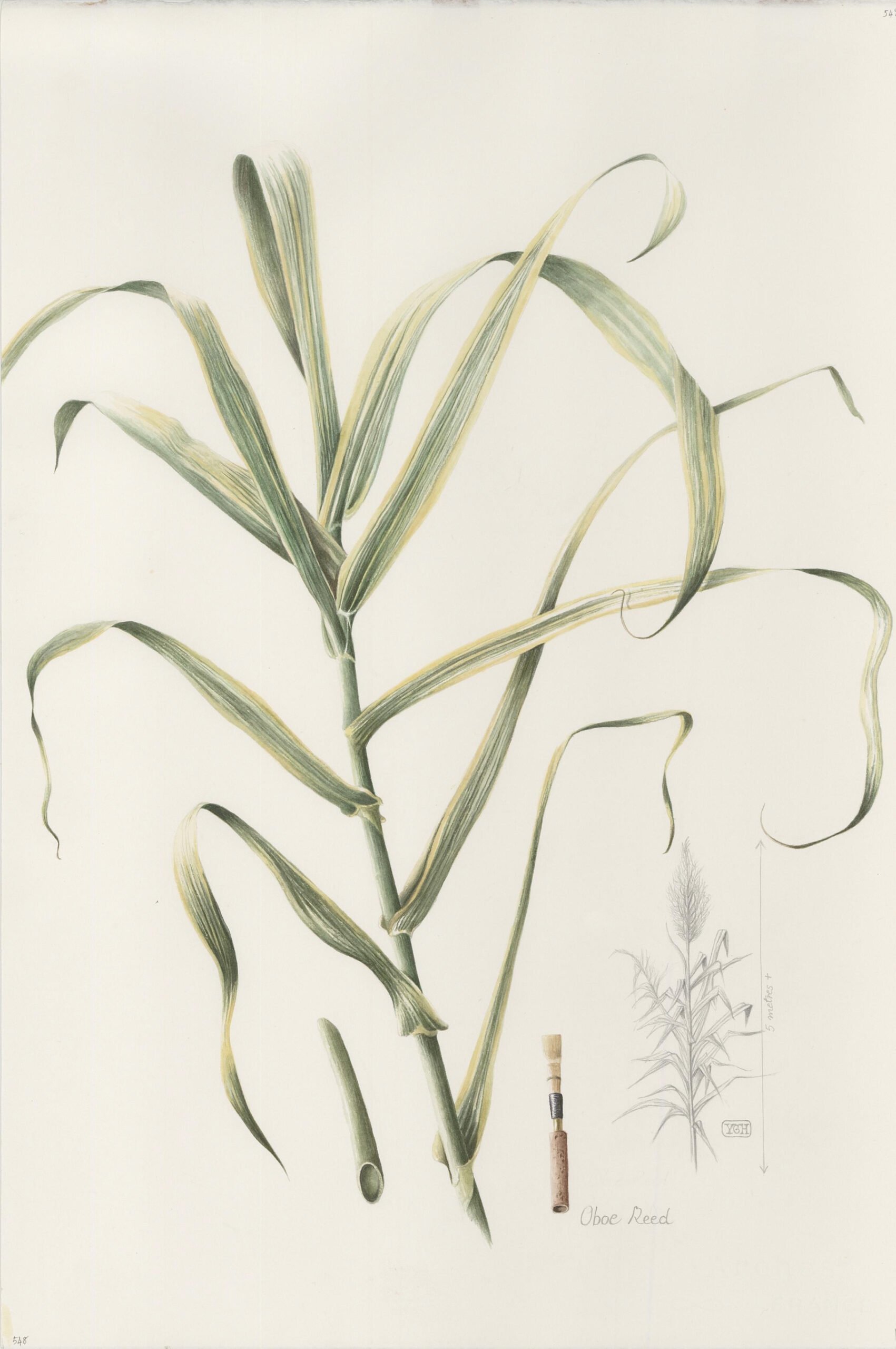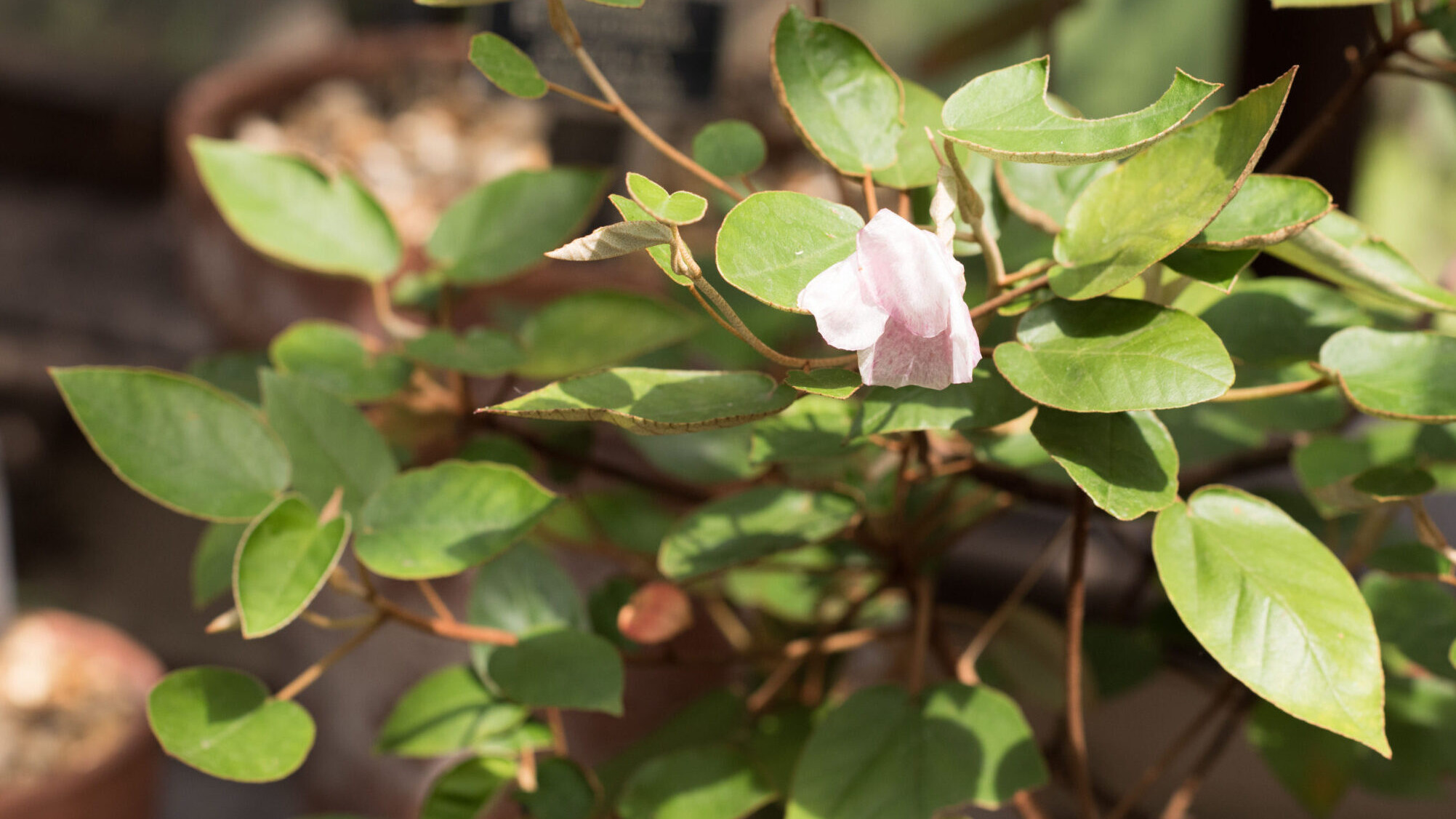The species we mourn and the ones we blame
By Eve Barro, Assistant Project Curator at Chelsea Physic Garden
This month I investigated plant biodiversity. It became obvious that the ecosystems that constitute our environment are governed by fragile equilibria. When they get disrupted, it affects others in sometimes unexpected ways, leading to the displacement and extinction of species. Understanding our environment and the ways in which it can get disrupted seems crucial if we are to live within it in a non-destructive way.
Many of the plants grown at Chelsea Physic Garden are endangered in the wild. A perfect example of this is the island endemic Trochetiopsis ebenus (Saint Helena ebony), which almost disappeared after the introduction of an invasive species on the island of Saint Helena. The biological invasion of alien species is the fourth most common threat to plant diversity (1). Several of the plants at Chelsea Physic Garden, such as Arundo donax (giant reed), are considered to be invasive species in some places of the world (2). However, what we often forget is that most alien species have actually been introduced by humans. In this blog post I decided to focus on two plants, Trochetiopsis ebenus and Arundo donax, to understand what makes plants threatened or invasive, how they relate to each other, and what is our level of responsibility and potential for regenerative intervention in contexts of ecosystem disruption. These two plants have opposite but shared stories, like two sides of the same coin.
Research suggests that the ancestors of the extant Trochetiopsis species (extant species are species that are still in existence) arrived on Saint Helena by long distance dispersal from AfricaFossil pollen records show that ancestors of the extant Trochetiopsis species were present on Staint Helena at least eight million years ago (3, 4). The adaptation and evolution of the group led to three distinct species of Trochetiopsis: species Trochetiopsis ebenus (Saint Helena ebony), Trochetiopsis melanoxylon (dwarf ebony) and Trochetiopsis erythroxylon (Saint Helena redwood). For eight million years the genus was relatively undisturbed on the island.
Today Trochetiopsis melanoxylon is extinct, Trochetiopsis erythroxylon is extinct in the wild and Trochetiopsis ebenus is critically endangered.


Arundo donax has a very long ethnobotanical tradition around the Mediterranean Basin. The plant is said to have greatly contributed to the western culture as it allowed the development of music. Indeed, as early as 5000 years ago, it was used to make pan pipes. Before that, the Egyptians used it to line the walls and floor of underground grain stores and wrap mummfied bodies in its leaves. They also used the plant for basketry, to make fishing rods and writing tools (5). The plant is also widely used medicinally. In Ayurveda, it is used as a vasopressor (to elevate arterial pressure) and to treat urinary disorders. A decoction of its rhizome is used as a diuretic (increasing the production of urine), menstrual stimulator and galactagogue (enhancing lactation) (6). Today some refer to Arundo donax as a “noxious weed”.
How did Arundo donax go from being one of the most useful and versatile plants used by humans to be called a “noxious weed”? And how did Trochetiopsis ebenus, a species which genus flourished for more than eight million years on Saint Helena, come to be the only survivor of its genus and critically endangered? Unfortunately, anthropogenic changes are a big part of the answer.
In the 1820s, Arundo donax was introduced in the Los Angeles Basin area for erosion control. It rapidly escaped and spread throughout the southern and southwestern states of the United States. Alien invasive species often thrive in new environments because they are freed from the competition and predation that existed in their native environment. In California, it is estimated that 68% of riparian vegetation is now composed of the plant, which is displacing native vegetation that usually provides nesting sites for federally endangered and threatened bird species (7,8,9). The introduction of Arundo donax, and a later failed attempt at managing its spread, has led to the threatening of native species and local biodiversity.
Three hundred years before that, in the South Atlantic Ocean, Trochetiopsis ebenus (Saint Helena Ebony) was threatened by another species introduced by humans, and which turned out to be invasive: goats. The Portuguese encountered Saint Helena in 1502. At the time they did not establish a permanent settlement there but left goats so that they would provide food for passing ships in the middle of the route from the Cape to the Canaries and Madeira(10). The goats soon became uncontrollable and uncontrolled like Arundo Donax. In the early nineteenth century, the governor of Saint Helena recommended that local landowners confined or “removed” the goats (11). However, these management methods were not quite effective enough, and Trochetiopsis ebenus was last seen by British naturalist Charles Melliss at the end of the nineteenth century (12).
The situation can seem hopeless. Species are disappearing at a rate far greater than could be expected without human action Humans have, in the past, translated species to new ecosystems for their own benefit, now ecosystems are collapsing. But there is hope. We can learn from our errors and make sure we know how to control a species before introducing it to a new environment. In the United Kingdom for example, the Wildlife and Countryside Act has prevented the “release into the wild of certain plants and animals which may cause ecological, environmental, or socio-economic harm” since 1981 (13).
What about Trochetiopsis ebenus (St Helena ebony) and Arundo Donax (giant reed)? There is hope for them too. In fact, Trochetiopsis ebenus (St Helena Ebony) was thought to be completely extinct for about one hundred years when…it was discovered, still growing on a cliff that goats could not reach on Saint Helena island! (4) It was also discovered that Arundo donax does not spread easily in environments where there is little disturbance (no strong flood events, storms or machinery). A careful monitoring and analysis of the environment in which the plant is introduced could thus allow its proper management (14).
There are many invasive and threatened species at Chelsea Physic Garden. Giving them this status is helpful to implement conservation strategies but the context in which they became invasive or threatened is equally important as it is often linked to anthropogenic changes that we could mitigate.
Are you interested in reading more about how botanical gardens can inspire us to take a better care of natural biodiversity? Keep an eye out for the first edition of our zine on biodiversity, for sale in our Shop!
To know more
Box, O. (2022). A weed is but an unloved flower. JSTOR Daily. https://daily.jstor.org/a-weed-is-but-an-unloved-flower/
Grove, R. (1997). Green imperialism: Colonial expansion, tropical island Edens and the origins of environmentalism, 1600 – 1860 (1. paperback ed., reprinted). Cambridge Univ. Press.
Kimmerer, R. W. (2020). Braiding sweetgrass indigenous wisdom, scientific knowledge, and the teachings of plants (Second hardcover edition). Milkweed Editions.
Turner, J. (2022). National Flower: Unique to St Helena. Saint Helena Island Info. http://sainthelenaisland.info/nationalflower.htm
References:
(1)Bellard, C., Cassey, P., & Blackburn, T. M. (2016). Alien species as a driver of recent extinctions. Biology Letters, 12(2), 20150623. https://doi.org/10.1098/rsbl.2015.0623
(2)Lowe, S., Brown, M., Boudjelas, S., & De Poorter, M. (2000). 100 of the World’s Worst Invasive Alien Species A selection from the Global Invasive Species Database. Invasive Species Specialist Group.
(3)Q.C.B., C. (1990). The history of the endemic flora of St Helena: Late Miocene:‘Trochetiopsis-like’ pollen from St Helena and the origin of Trochetiopsis. New Phytologist, 114, 159–165.
(4)Turner, J. (2022). National Flower: Unique to St Helena. Saint Helena Island Info. http://sainthelenaisland.info/
(5)Hardion, L., Verlaque, R., Saltonstall, K., Leriche, A., & Vila, B. (2014). Origin of the invasive Arundo donax (Poaceae): A trans-Asian expedition in herbaria. Annals of Botany, 114(3), 455–462. https://doi.org/10.1093/aob/mcu143
(6)Kumar, P., Singh, S., Sharma, A., Kaur, G., Kaur, R., & Singh, A. N. (2021). arundo donax l.: An overview on its traditional and ethnomedicinal importance, phytochemistry, and pharmacological aspects. Journal of Herbmed Pharmacology, 10(3), 269–280. https://doi.org/10.34172/jhp.2021.31
(7)Hardesty-Moore, M., Orr, D. & McCauley, D.J. Invasive plant Arundo donax alters habitat use by carnivores. Biol Invasions 22, 1983–1995 (2020). https://doi.org/10.1007/s10530-020-02234-4
(8)Herrera, A. M., & Dudley, T. L. (2003). Reduction of riparian arthropod abundance and diversity as a consequence of giant reed (Arundo donax) invasion. Biological Invasions, 5, 167–177.
(9)Bell, G. P. (1997). Ecology and management of Arundo donax, and approaches to riparian habitat restoration in southern California. In Plant Invasions. Studies from North America and Europe (pp. 103–113). Backhuys Publishers.(10)Lamb, J. (2016). The curious case of island-dwelling goats. JSTOR Daily.
(11)St Helena Governor and Council . (1810). Papers relating to the devastation committed by goats on the island of st. Helena, st. Helena (S. Solomon by J. Coupland).
(12)Scott, H. (2014). Victorian Microcosms: Domestic Systems. In Chaos and Cosmos: Literary Roots of Modern Ecology in the British Nineteenth Century (pp. 118–140). Penn State University Press.
(13)Defra UK. (2011). Preventing the release into the wild of certain plants and animals: Guidance. Department for Environment, Food and Rural Affairs.
(14)Minogue, P., & Wright, S. (2015). BIOLOGY, CONTROL AND INVASIVE POTENTIAL OF GIANT REED (ARUNDO DONAX L.) IN FLORIDA. School of Forest, Fisheries, and Geomatics Sciences, UF/IFAS Extension.

